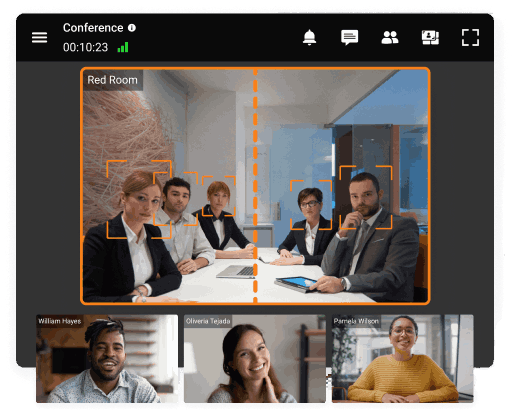How Artificial Intelligence and Data Science Work for an Online Conference?
Artificial Intelligence (AI) is a self-learning program that helps to implement creative tasks that were previously considered exclusively the prerogative of a person. This system is one of the most important scientific achievements of recent decades, as it has opened access to a variety of technological solutions that previously seemed like a real fantasy.
Artificial Intelligence (AI) has initiated a revolution in contemporary communication, ushering in significant transformations across diverse domains. With the right artificial intelligence course, professionals can deepen their understanding of AI’s capabilities and leverage its proficiency in managing substantial data volumes and discerning intricate patterns.
AI-driven language translation services have bridged language barriers, rendering global communication effortless. Voice assistants like Siri and Alexa simplify tasks through voice commands, enhancing user convenience. Sentiment analysis tools help organizations gauge public opinion and customer emotions in real time, enabling more responsive and personalized communication strategies.
The field of video conferencing, which is closely linked to data science, has also been affected by this phenomenon of our time. Thanks to modern technologies, online meeting solutions have added many new features, drastically improving the quality of communication. In this article, we have gathered the most useful AI-based solutions offered by video conferencing providers that may be of interest to you and help you with your work.
Exploring Video Conferencing Capabilities with AI
AI opens up great opportunities not only for ordinary users, but also for business representatives. Both small companies and large organizations can take advantage of the benefits of video conferencing offered by the latest technological advances. AI-based capabilities not only include background replacement, which is already quite common among vendors, but also tools that enhance the productivity of collaboration.
Let’s take a closer look at the issue to gain an accurate understanding:
1. NLP to sharpen speaker’s voice
Natural Language Processing (NLP) is a branch of Al and mathematical linguistics that studies the problems of computer analysis and synthesis of texts in natural languages. This includes not only text generation, but also voice recognition, which are now actively being used in various fields, including video conferencing. This opportunity has led to the involvement of AI and AI Agents in various sound enhancement systems during online communication. In particular, many vendors are now actively adding, or have already added, the ability to sharpen the speaker’s voice.
Plenty of businesses are also using this technology to get unique contact center automation solutions for optimizing their contacts. The integration of AI goes beyond efficiency gains; it reshapes how businesses interact with customers and streamline complex tasks in various industries.
The NLP feature is especially important for users who often use video conferencing during business trips. Increasing the sharpness of the speaker’s voice significantly improves the quality of communication, even in noisy or crowded environments, which is very important for elevating customer service.
2. Voice-to-text transcription
Voice-to-text transcription has become one of the features that have significantly improved and simplified companies’ collaboration through video conferencing. Users no longer need to be distracted during online meetings by taking notes or endlessly rewinding the recording to find the most important parts of the discussion. It is enough to transcribe the active speakers’ speech and select the necessary fragments of the discussion into a ready-made text file. With the help of AI audio transcription and advanced LLM development services, organizations can now automate this process, increasing meeting accuracy and productivity across teams.
The fact is that regular meetings, which are necessary for productive activities, are typical not only for commercial organizations. Judicial authorities, law enforcement agencies, the navy, and rapid response services are just a few of the state spheres that use video conferencing to simplify and accelerate important decision-making. Because every word is important here, transcription allows employees to not miss a single important detail, which could potentially have a life-altering impact. They can also invest in RFP response automation to enhance efficiency, ensuring accurate and timely responses to requests while reducing manual effort and errors.
3. Analyzing meeting room
The ability of AI to recognize speakers’ voices makes online meetings even more convenient, thereby improving the quality of communication. With the help of special machine learning algorithms, users can automatically translate the words of their interlocutor, which is extremely important for international discussions. Additionally, an AI answer generator can assist by providing instant, relevant responses, streamlining discussions, and enhancing productivity during meetings. To make these responses feel more authentic, an AI humanizer can refine the generated content so it aligns more closely with natural human communication styles.
To further enhance the user experience, businesses can integrate product tour software into their communication platforms, helping participants quickly understand the features and tools available during a meeting. Such guided, interactive tours ensure that even new users can efficiently navigate the interface, access AI-powered functionalities, and fully leverage the platform’s capabilities without extensive training.
4. Computer vision for utmost video experience
Computer vision is a field of science that deals with creating and studying computer systems that have a high-level understanding of digital images or videos. Thus, not only scientists but also programmers are able to realize the tasks that the human visual system performs. In the case of AI, this function is implemented through convolutional neural networks (CNN), which are part of deep machine learning. As AI applications become more sophisticated, techniques like prompt versioning are crucial for optimizing AI performance, allowing continuous improvement and adaptation to user needs in real-time.
Computer vision is now being used to improve images and videos by studying and identifying areas that require improvement: noise reduction, contrast enhancement, brightness adjustment, and color balance. These capabilities are reflected in video conferencing, for which image quality is one of the most important factors. This isn’t just for video conferences but can also be applied to images.
The TrueConf AI Suite
Keeping up with the times, TrueConf solutions are equipped with advanced AI-based features that take communication to a qualitatively new level. Cutting-edge machine learning allows the solution to not only automatically generate a layout depending on the active speakers, but also to provide intelligent focusing if there are multiple users in the frame. Another convenient feature of TrueConf is the transcription of virtual meetings, which allows you to convert a conference recording into a detailed text. In the case of typical problems, a special AI-powered assistant will come to the rescue and provide useful tips on how to resolve the situation.
TrueConf!
When choosing a solution for online meetings, you can opt for TrueConf, which offers a completely novel experience of virtual interaction. Keep up with the times and enjoy the technologies of the future!
However, this is not the limit of TrueConf’s capabilities, as it offers a number of advanced features:
Smart Noise Suppression
TrueConf solutions are equipped with a noise reduction system that allows users to host video conferences even in an unfavorable environment, be it a crowded street or an industrial workshop. The built-in AI-based algorithm recognizes the source of interfering sounds and reduces its volume, leaving only the speaker’s voice audible. At the same time, the user does not need to worry about the details of the meeting: the system will take care of everything automatically.
Background blurring
Thanks to the technology of smart background blurring, the participants of the virtual discussion need not worry about their environment, no matter what happens. The AI-powered system ensures privacy of communication regardless of the background, even if you are in a public place. The participants of the video conference can only see you, helping to focus on the conversation and not be distracted by what is happening behind you.
AI Autofocus for Smarter Video Conferencing
The autofocus technology in modern video conferencing software uses AI-powered algorithms to enhance meeting experiences by intelligently framing participants. Autofocus on the Face automatically detects users’ faces and positions them in the center of the frame, removing unnecessary background space for a cleaner, more professional appearance. Autofocus on Participants goes a step further by bringing multiple remote users into a single, well-composed frame, ensuring that everyone is visible and properly positioned. These features not only improve visual clarity but also create a more engaging and natural meeting environment, allowing participants to focus on the conversation rather than camera adjustments.

AI User Assistant
User Assistant is a built-in smart feature designed to help participants overcome technical or common issues during video conferences without disrupting the meeting flow. If a problem arises—such as a muted microphone—the assistant automatically provides clear, on-screen hints so users can quickly resolve it, whether by unmuting, adjusting settings, or using alternative controls like “Push to Talk.” This proactive guidance ensures smoother communication, minimizes downtime, and reduces the need to contact an administrator, making virtual meetings more efficient and user-friendly. For businesses relying on efficient operations, having access to high-quality industrial parts is essential. Trusted suppliers help companies maintain performance with reliable components.

AI-based Video Conferencing Use Сases
E-learning
Tools for blurring and replacing the background, along with an intelligent noise reduction system, help to keep the focus on the lesson topic, thereby increasing productivity in remote education.
Telemedicine
During a remote consultation, smart algorithms take over certain tasks of the doctor, such as protocolling a patient’s medical history.
Public Sector
The combination of automatically protocolling conferences and smart layouts greatly simplifies the conduct and management of remote meetings.
Conclusion
Time does not stand still: likewise, the development of technologies constantly offers more and more new opportunities. Thanks to the flexible capabilities of artificial intelligence and machine learning, video conferencing is moving to a new level of convenience, providing users with uninterrupted and high-quality communication no matter where they are.
About the Author
Nikita Dymenko is a technology writer and business development professional with more than six years of experience in the unified communications industry. Drawing on his background in product management, strategic growth, and business development at TrueConf, Nikita creates insightful articles and reviews about video conferencing platforms, collaboration tools, and enterprise messaging solutions.





Follow us on social networks